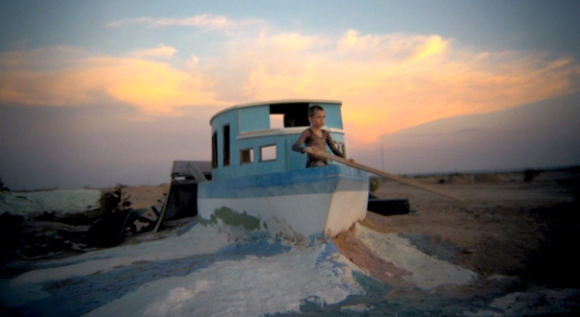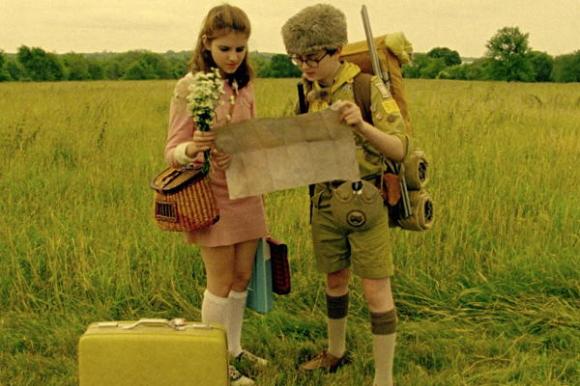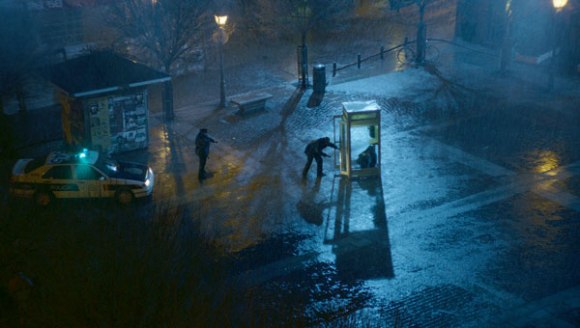Yes, that’s right, part one. The traditional best-of list follows, with an upcoming collection of awards for stuff that might have escaped mention here. As always, there are films I didn’t get to see in time that will probably be on next year’s list, and films that I liked but not enough to make the cut. And now, on with the show.
 15. Bombay Beach
15. Bombay Beach
Dir. Alma Har’el (USA, 2011)
80 minutes
Bombay Beach is a strange, impressionistic documentary that values aesthetics over reportage. It looks into the lives of individuals and families in a run-down lakeside community in California that we would otherwise dismiss or never even hear of, and shows them as simply people, trying to make the best of a bad situation, but all capable of connection and love. It’s impossible to watch scenes like the Parish family struggling with their ADHD son, or the old man who philosophises to the camera about the hard life he’s led, and not see them as people who deserve far more than what they’ve been given.
But the film doesn’t contend itself with “realist” documentary miserablism. There are wonderful moments where the participants dance amid the semi-rural decay of Bombay Beach while the Beirut/Bob Dylan soundtrack thrums beautifully in the background; scenes that imbue their run-down surroundings with a kind of dreamlike beauty. It’s “anti-realist” in the best possible way; it shows an ideal of a better world and lets this world’s inhabitants act it out.
 14. Killer Joe
14. Killer Joe
Dir. William Friedkin (USA, 2012)
102 minutes
This was the year that Matthew McConaughey became an actor I took seriously, and a lot of that had to do with his revelatory performance in Killer Joe; a comically heightened Southern-fried pulp/noir blowout that gradually morphs into a folkloric cautionary tale of what happens to people who invite evil into their lives. The final extended scene betrays its stage-play origins, but the go-for-broke insanity of the whole thing (McConaughey in particular) turns it into a viscerally disturbing black comedy tour-de-force.
 13. Carancho
13. Carancho
Dir. Pablo Trapero (Argentina, 2010)
107 minutes
A bracingly nasty Argentinian neo-noir, unashamed to have its protagonist plumb the depths of scumbaggery. He’s a disgraced lawyer turned ambulance chaser (the “vulture” of the title) who’s not above faking accidents with the help of homeless people to earn some extra cash. Scuttling through the endless night of Buenos Aries, he strikes up a relationship with a paramedic who’s developing an addiction to opiates.
It’s dark stuff, but there’s room for a tender love story that, as with all things in this film, shades into desperation as the couple struggle to escape the corruption all around them. Gritty, hand-held cinematography chases the characters through ever-narrowing avenues. Crunching collisions of metal soundtrack a story about the trauma inflicted by a brutal world.
 12. Looper
12. Looper
Dir. Rian Johnson (USA, 2012)
118 minutes
Looper starts out as a zippy, high-concept sci-fi/noir exercise but quickly goes to some pretty dark places as it asks questions about how much of other people’s futures we would sacrifice to protect our own past. There’s also a weighty element of subtext on arrogant old age meeting cocksure youth, and the blame directed to the previous generation for leaving the present a screwed-up world.
Weird facial prosthetics aside, Joseph Gordon-Levitt is pretty great, Willis actually seems to be trying and there’s a great scene-stealing turn from Jeff Daniels as a hangdog crime boss. The cinematography and production design conjures some unique images from among the fields and run-down post-industrial cityscapes of 2044. The restless camera tilts and whirls during the shootouts and chases, keeping us as disoriented as the uncomfortable ambiguities in the script.
 11. Chronicle
11. Chronicle
Dir. Josh Trank (USA, 2012)
84 minutes
Like the most effective B-movies, Chronicle takes a simple premise (teens gain superpowers, document the experience via camcorder) and makes much more out of it. As with most found-footage movies, the filmmakers have to strain a bit to stick to the gimmick (although the characters’ powers do make for an elegant way around some obstacles). It turns from a teen drama to something far bigger and more disturbing, without sacrificing the low-key presentation – which at times makes it feel almost like a horror film. It’s one of the (very) few superhero movies I’ve seen that actually puts across how weird and unsettling superpowers would actually be.
You can read it as many things: as a film about the emotional and moral consequences of living in a world of social media, where being the star of your own movie necessarily relegates others to bits parts. As a critique of the superiority complex inherent in most superhero narratives. As a questioning of why our culture’s dreams are so often ones of power, violence and rage. And none of this subtext ever overwhelms the drama.
 10. Hara-kiri: Death of a Samurai
10. Hara-kiri: Death of a Samurai
Dir. Takahshi Miike (Japan, 2011)
126 minutes
Miike returns to historical samurai drama after 13 Assassins, toning down the delirious ultraviolence of that film to offer something more cerebral, but no less gripping. Narrative expectation is upended is the story we think we are watching becomes about something else entirely. Miike uses the conventions of stately, classical samurai films to deconstruct not only the much-romanticised historical period, but the films that portray it admiringly; the chivalry and codes of honour are a farce, as hollow as an empty suit of armour.
 9. The Raid
9. The Raid
Dir. Gareth Evans (Indonesia/USA, 2011)
101 minutes
All-time outstanding achievement of this year in wrecking shit. Brutal, non-stop violence as a small group of cops take on an army of crooks in a tower block turned warzone. An action movie that’s inspiring for how well it lives up to its promise, and for its utter stripped-to-the-bone commitment to mayhem. Every perfectly-choreographed storm of blades, feet and fists is a gauntlet thrown down to everyone else working in this area, saying: Raise Your Game.

8. Haywire
Dir. Steven Soderbergh (USA, 2011)
93 minutes
Almost the opposite number to the previous entry, this is a series of bone-crunchingly realistic fight setpeices set within a classic Soderbergh “process” film about characters who are defined by their jobs, and all the little actions they perform in service of those professions. In using an actual professional fighter as lead, Soderbergh can stage lengthy, complex fights where you see the characters work out in real time the best move to make. Every grab, punch, kick and slam is just professionals doing their thing.
There are so many funny moments – the guy under the door giving the finger, Carano running into shot behind a certain character, the final line – and a pleasingly retro jazzy soundtrack, that make it obvious Soderbergh’s having great fun with this. That it refuses to take itself too seriously is a big part of the film’s charm.
 7. Miss Bala
7. Miss Bala
Dir. Gerardo Naranjo (Mexico, 2011)
113 minutes
A brutal and often viscerally uncomfortable chronicle of the violence done to innocents in Mexico’s drug war, which achieves its aim through monomaniacal focus of one of those innocents. Our protagonist Laura is rarely off screen; the camera tracks her constantly like a lover (or a stalker). The film unfolds in a series of long takes that create an unbearable claustrophobia; we are trapped in each scene with Laura as she struggles to get out of every situation alive. (A sequence where she emerges from a crashed car into a running gun battle between cops and criminals has its own surreal beauty.) It’s an unflinching exploration of how corruption chews up and spits out anyone who tries not to take a side.
 6. Moonrise Kingdom
6. Moonrise Kingdom
Dir. Wes Anderson (USA, 2012)
94 minutes
Anderson fully indulges in whimsy and building perfect diorama-like worlds even as he delivers his saddest and most honest story, about a forbidden romance and elopement between two kids leading the adults around them to assess where their lives have gone wrong. In a sly inversion of their usual personae, Ed Norton and Bruce Willis play the pair of sad sacks in charge of the search efforts, and regular Anderson players Bill Murray and Jason Schwartzman make welcome appearances. but the film truly belongs to Jared Gilman and Kara Hayward as the lovestruck couple lighting out into the wilderness. Alternating between slapstick and poignancy, it all builds to a rousingly silly climax that still allows for a lot of heart; a perfectly constructed gem.
 5. Killing Them Softly
5. Killing Them Softly
Dir. Andrew Dominik (USA, 2012)
104 minutes
Grimy and despairing, this ultra-downbeat crime drama filters its narrative through the financial collapse and Presidental election campaign of 2008 to tell a story of an America where the most secure institutions and the rules they play by seem to be in slow-motion collapse.
A pair of scuzzy, none-too-bright low-level hoods (Scott McNairy and Ben Mendelsohn) rip off a mob card game in an excruciatingly tense sequence. Brad Pitt is the consummate professional brought in to clear up the mess, but continually stymied by the equivocations of his bosses and the incompetence of his peers (including James Gandolfini in a film-stealing performance as a lugubrious, alcoholic hitman).
The film takes place in a New Orleans more decaying and rain-lashed the the anonymous metropolis of Fincher’s Se7en, playing on the theme of how capitalism devours its own without knowing or caring. It’s as brutal with the ways people can manipulate others into doing their bidding as it is with the beatings and shootings. The whole sordid story builds to a black-hearted punchline that equals the ending of There Will Be Blood for sheer mordant humour.

4. The Imposter
Dir. Bart Layton (UK, 2012)
99 minutes
A supremely unsettling documentary, which uses its anti-realist techniques (such as reconstructions often overdubbed with the participants’ own voices) to draw the audience into the sheer bizarreness of its story and the twists encountered on the way. It owes a lot to Errol Morris (said reconstructions, the Interrotron-style presentation of interviewees speaking straight to camera), and is similarly concerned with his regular themes of the flexibility of truth and the stories people tell to conceal unpalatable facts from others and from themselves. Unfortunately, that to tell much more would spoil the effect, so I’d ask everyone to go see it with as little information as possible, and get caught up in the stomach-churning series of revelations.
 3. Rust and Bone
3. Rust and Bone
Dir. Jacques Audiard (France/Belgium, 2012)
120 minutes
What could be worthy, melodramatic subject matter is given real weight by the naturalistic direction and the raw power of Cotillard and Schoenaerts’ performances. The film is unabashedly rooted in the physical; Audiard’s camera lingers on flesh and skin in all its rough beauty, variously scarred, bloodied and tanned by the sun. Vulnerability comes through at every turn, with the characters’ interactions alternating between brutality and tenderness. The coupling of physical and emotional trauma is key to this story of damaged bodies, damaged people, and what it means to heal.
 2. The Master
2. The Master
Dir. Paul Thomas Anderson (USA, 2012)
137 minutes
A film that demands to be seen on the biggest screen possible; huge landscapes and the surface of individual human faces are given the same level of loving, detailed exploration. Phoenix and Hoffman are truly exceptional; every indication you’re watching an actor perform falls away as you’re lost in the fine details of these characters. It’s a thorny, paradoxical tale of two men struggling with the unspoken connection they appear to have, both too headstrong to settle into the simple prophet-and-follower pattern. Set against the dawn of 50s conformism, it shows people who yearn for something more, wrestling with their own natures, trying to make sense of their lives. But even setting the acres of subtext aside, it’s as rewarding to simply enjoy the film as a gorgeous tactile thing and luxuriate in it.

1. Holy Motors
Dir. Leos Carax (France/Germany, 2012)
115 minutes
Leos Carax’s latest film makes no attempt to disguise its self-reflexive nature; it’s an endless hall of mirrors of film commenting on film. The tale of one day in the life of “Monsieur Oscar” (Denis Lavant), being chauffered around Paris in a limousine between different “assignments”, laboriously applying different disguises as he goes, is the framework on which Carax hangs a number of vignettes from downbeat drama to farce, with room for a musical number or two.
All of the surreal moments and Russian-doll nesting of different performances could make it very arch and distant, but there are moments of real emotional heft. Lavant’s weathered face has a kind of ruined charisma that shines through all the disguises and prostheses – whether dressed to the nines or clad in rags, he looks like a man who has seen far too much, and knows he’ll have to see much more. There’s a moment where he and Kylie Minogue (yes, really) take a walk through a derelict department store, reminiscing about the past. And while we’re unsure whether they are both actors taking a moment to acknowledge their past relationship, or whether they’re both just playing another role, it’s a truly moving bit of acting by them both.
With its irrepressible bursts of silliness and refusal to stay still, this is a film lovers’ film in the best way possible – so convinced of the possibilities of the form it’s hard not to get caught up in its enthusiasm yourself.
And as a bonus, the best non-2012 films I saw for the first time this year (please excuse my embarrassment at the number of classics I’ve somehow only just got round to watching):
Dave Chappelle’s Block Party (Gondry, 2006), Blue Valentine (Cianfrance, 2010), Contagion (Soderbergh, 2011), Eraserhead (Lynch, 1977), Hard Eight (Anderson, 1996), Shaft (Parks, 1971), P.T.U. (To, 2003), Ashes and Diamonds (Wajda, 1958), Targets (Bogdanovich, 1968), A Clockwork Orange (Kubrick, 1971), Double Indemnity (Wilder, 1944), The Driver (Hill, 1978), Rope (Hitchcock, 1948), Groundhog Day (Ramis, 1993), Fat City (Huston, 1972), Certified Copy (Kiarostami, 2010), Le Cercle Rouge (Melville, 1970), The Last Detail (Ashby, 1973)
Part Two coming soon…

